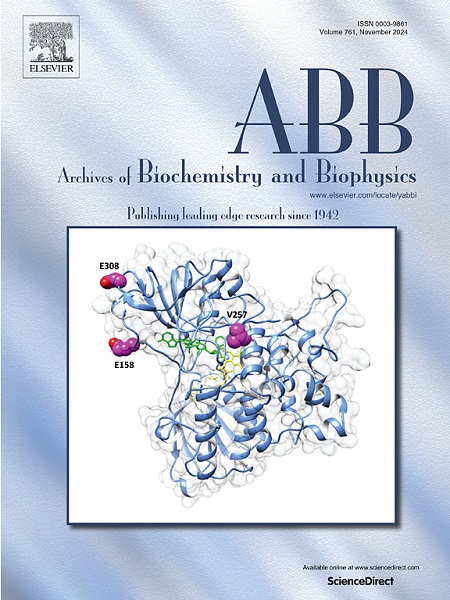不同壳厚的二氧化硅层氧化铁纳米复合材料的辐射敏化影响评估
IF 3.8
3区 生物学
Q2 BIOCHEMISTRY & MOLECULAR BIOLOGY
引用次数: 0
摘要
二氧化硅外壳被认为是一种很有前途的设计,可以通过克服生理条件下的聚集性来增强纳米复合材料的稳定性、细胞内化和相应的治疗效果。本研究旨在合成具有不同壳层厚度(1-SCINPs, 2-SCINPs, 3-SCINPs和4-SCINPs)的二氧化硅层状氧化铁基纳米颗粒(SCINPs)。此外,还评估了壳厚度对纳米颗粒细胞内化的影响以及制备的纳米制剂的放射增敏效应。采用透射电子显微镜(TEM)、原子力显微镜(AFM)、动态光散射(DLS)、振动样品磁强计(VSM)和x射线衍射(XRD)对合成的纳米粒子的物理性质进行了表征。采用细胞毒性试验、氧化应激参数和彗星试验研究了不同纳米制剂的放射增敏效应。结果表明,所制备的氧化基纳米颗粒(INPs)的平均直径约为12.63±1.36 nm, 1-SCINPs、2-SCINPs、3-SCINPs和4-SCINPs的壳厚分别为22.58±3.51、26.13±1.40、46.95±3.10和60.30±4.30 nm。有趣的是,我们发现在40μg/ml的INPs处理下,细胞存活率下降到44.6%。同时,1-SCINPs和2-SCINPs处理的细胞存活率分别为41.69%和39.4%。这意味着较厚的二氧化硅外壳导致对放射敏化的影响降低。这归因于SCINPs的表面性质和尺寸对其细胞摄取的影响,以及辐射暴露后次级电子在较厚的外壳内的捕获。细胞活力试验、彗星试验和氧化应激参数表明,2-SCINPs制剂与放射治疗联合使用时具有最强的放射增敏效应(最高剂量增强因子为2.1)。结果表明,优化硅壳厚度是提高SCINPs治疗效果的关键,其中2-SCINPs表现出最高的放射增敏效果。本文章由计算机程序翻译,如有差异,请以英文原文为准。

Radiosensitization impact assessment of silica-layered iron oxide nanocomposites with various shell thickness
Silica shell is considered to be a promising design that enhances nanocomposite stability, cellular internalization, and consequentially therapeutic impacts by overcoming their aggregation under physiological conditions. This study addressed synthesizing silica-layered iron oxide-based nanoparticles (SCINPs) with different shell thicknesses (1-SCINPs, 2-SCINPs, 3-SCINPs, and 4-SCINPs). Also, the impact of shell thickness on the nanoparticle's cellular internalization and the radio-sensitizing effect of prepared nano-formulations were assessed. The physical properties of the synthesized nanoparticles were examined using transmission electron microscopy (TEM), atomic force microscopy (AFM), dynamic light scattering (DLS), vibrating sample magnetometry (VSM), and X-ray diffraction (XRD). Cytotoxicity assay, oxidative stress parameters, and comet assay were used to investigate the radio-sensitizing effect of various nanoformulations. Results revealed that the mean diameter of prepared oxide-based nanoparticles (INPs) was about 12.63 ± 1.36 nm, and the shell thickness for 1-SCINPs, 2-SCINPs, 3-SCINPs, and 4-SCINPs was 22.58 ± 3.51, 26.13 ± 1.40, 46.95 ± 3.10 and 60.30 ± 4.30 nm, respectively. Interestingly, we found that in cells treated with 40 μg/ml of INPs, their viability decreased to 44.6 %. Meanwhile, the viability was 41.69 % and 39.4 % for cells treated with 1-SCINPs and 2-SCINPs, respectively. This means that a thicker silica shell led to a decreased impact on radiosensitization. This was attributed to the influence of surface properties and size of SCINPs on their cellular uptake and the secondary electrons' entrapment within thicker shells upon radiation exposure. Cell viability test, comet assay and oxidative stress parameters show that 2-SCINPs formulations had the most potent radiosensitizing effect (with the highest dose enhancement factor equal to 2.1) when combined with radio-treatment. The results suggest that optimizing the silica shell thickness is critical for maximizing the therapeutic efficacy of SCINPs, with 2-SCINPs showing the highest radiosensitization effect.
求助全文
通过发布文献求助,成功后即可免费获取论文全文。
去求助
来源期刊

Archives of biochemistry and biophysics
生物-生化与分子生物学
CiteScore
7.40
自引率
0.00%
发文量
245
审稿时长
26 days
期刊介绍:
Archives of Biochemistry and Biophysics publishes quality original articles and reviews in the developing areas of biochemistry and biophysics.
Research Areas Include:
• Enzyme and protein structure, function, regulation. Folding, turnover, and post-translational processing
• Biological oxidations, free radical reactions, redox signaling, oxygenases, P450 reactions
• Signal transduction, receptors, membrane transport, intracellular signals. Cellular and integrated metabolism.
 求助内容:
求助内容: 应助结果提醒方式:
应助结果提醒方式:


